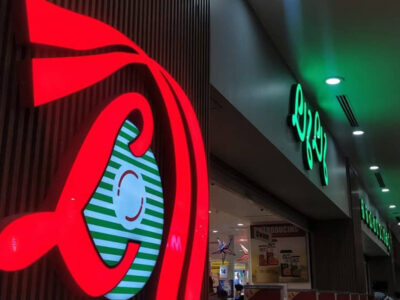Jeremy Johnston, CEO of MAF Fashion, is a man generally at ease with the world, smartly dressed in a trendy suit yet seemingly not overawed by his position. Even the office in which he greets me is light, modern and airy, reflecting the relative newness of this branch of the Majid Al Futtaim empire.
Founded in late 2005, MAF Fashion was initially conceived as a solution to cater for clothing label Mexx, which had decided to find one substantial local partner to manage the brand in the Middle East rather than several disparate agents. MAF was approached with a view to forming a strategic alliance, which eventually led to Mexx’s parent company Liz Claiborne agreeing to a much larger partnership. Once the dust had settled, MAF Fashion, with the sole wholesale and retail rights for the 50 different labels under the Liz Claiborne umbrella, set about buying out the existing franchises in Saudi Arabia, Bahrain and the UAE and began to launch core labels as stand-alone brands in the region.
As Johnston proudly explains, this arrangement has allowed the company to hit the ground running: “That gave us a nucleus of 70-odd stores spread around the GCC. Saudi is a really important market for us because over half of our Mexx stores are there, and after the deal was struck we opened a number of other Liz Claiborne brands. What makes it really interesting is that we have the rights to those brands not just in the Middle East, but also in North Africa, Turkey, Cyprus and Pakistan so there’s a substantial geographical remit.”
It’s about how you see yourself and how you feel.
Last year the company set about conquering the regional market by opening, amongst others, its first Lucky Brand jeans stores in the UAE, Kuwait and Saudi Arabia, some accessories shops, and the Liz Claiborne label itself, with each brand targeting a specific market segment. “Lucky Brand is really interesting, it’s got the best range of denim for guys and particularly for girls, it’s from the West Coast of the US and very hip,” says Johnston. “Then Liz Claiborne itself is for the woman that wants to dress that little bit smarter or more formally, career wear. There’s a bit less competition in that sector than, say Mexx or other fashion brands, and we’re feeling the benefits of its revitalisation in the US.”
The current ‘jewel in MAF Fashion’s crown’, and the brand that Johnston is most proud of, is Juicy Couture. The first store was rolled out to a great fanfare of publicity with a fashion show in the Jumeirah Emirates Towers in Dubai and appears to already be paying dividends. “It’s one of the hottest labels in America and it’s taken the market by storm,” he says. “It’s a huge, rip-roaring roller coaster of a success. It’s a luxury brand that’s very hip, that everyone has heard of and wants to be involved with, celebrities like Madonna wear it.” Although my carefully neutral expression reveals my lack of fashion credentials as Johnston laughs: “Ok, obviously not with you, but it is absolutely huge!”
With the amount of disposable consumer income in the regional market, retailers are avoiding targeting brands at specific age groups, preferring instead to cast the net wider. “A lot of labels now refuse to talk about their products in terms of age profile,” explains Johnston when I ask whether Juicy would be aimed at twenty-to-thirty-somethings. “It’s more a ‘lifestyle concept’ that’s going to appeal to people from 18 to 50 and over. It’s about how you want to see yourself and how you feel.”
This plethora of new launches, and accessibility to international brands, contrasts sharply with Johnston’s first experience as a retailer in the Middle East. Partly from a desire to add an international angle to his portfolio and partly to witness the emerging regional boom first hand, Johnston, as he puts it, left the “rain-lashed, recession-hit UK” for the: “wonderful sunshine and blue skies and an open playing field in terms of retail opportunities” of Kuwait in the 1990s.
Because the retail revolution at the time was still in only its early stages, Johnston’s overview of the regional market encompasses both ends of the scale. “In those days it was quite easy to kid oneself that one was God’s gift to retail,” he admits. “You could pretty well open any new brand in any new mall and it would be guaranteed to be profitable and pay back any investment in a matter of months. The main difference between then and now is that, these days, competition is intense and getting evermore so. All the retail businesses here are finding it, generally speaking, more difficult to make easy money.”
With the increase in the number, and types, of competitors in the marketplace, retailers are having to focus more closely on the bottom line. “I think that the days of making easy money from retailing, especially fashion retailing, are long gone,” says Johnston. “Now there is much more to worry about: How to generate sales; how to control your margins and overheads – if you concentrate you will probably make a reasonable returns. Of course you had to think about that in the old days but probably not in the microscopic way one now has to.”
Certain aspects have remained similar however, and Johnston finds that regional consumers’ shopping styles have not changed enormously, to MAF Fashion’s advantage and detriment. “There’s always a huge demand for something new,” he explains. “So when you’ve got a brand like Mexx, that’s been in the market since 1994, it’s a blessing and a curse. You’ve got a core customer base that’s loyal, but people also get bored with brands that have been around for a while. One of the key features of the market is that shopping is one of the things that the Middle East is famous for, but people go shopping so often, three or four times a week, that they get bored very quickly. You really have to strive to keep new ideas coming in.”
As well as the drive to differentiate their brands to consumers, regional fashion retailers also have to compete to attract international labels. “There just aren’t that many ‘power brands’ that are left to bring into this part of the world,” says Johnston. “Everybody and his dog that has any inclination to go into business, everybody wants to partner with – there’s so few brands. It’s another indication of how competitive the market is.
Although a stand-alone business under the MAF Ventures wing, with its own management structure, strategy and budget, MAF Fashion is able to take advantage of its connection to the parent company to use as a selling point for prospective partners. “One of the things about this part of the world is that, at the moment, there’s a retail crunch,” he explains. “There’s a lack of shop space, and most of the malls that are set to open in the next few years are already choc-a-bloc booked up with a long line of people waiting to take a space if someone pulls out. So any brand looking to come out here and set up with a partner has a problem in where it’s going to go. Our advantage is that, with our link to the MAF Malls we have slight advance notice and can be optimistic about getting good spaces for our clients.”
Everybody and his dog that has any inclination to go into business, everybody wants to partner with – there’s so few brands [left to come into the region].
As part of his strategy for driving MAF Fashion forward, Johnston has created a separate division to deal specifically with new business development and planning future brands, and geographical, roll-outs. “Having people who report to me who are dedicated to researching potential markets is great because then it allows the other managers to concentrate on their products and returns without being distracted. I didn’t want people taking time out of the core business and dropping the ball,” he says. “I can then oversee both aspects. I’m also lucky to have a good team. I don’t constantly have to poke my nose into what’s going on in a particular store and I’m not getting phone calls from staff – I’d be quite happy to, but I have people who take care of the minutiae.”
The use of carefully selected vocabulary such as this gives an insight into Johnston’s background as a graduate of Oxford University with an Arts degree, but the history scholar explains that this had very little influence on his decision to head into the retail sector. “I do sometimes ask myself why I did, particularly when business is slowing down and I see my friends from university who went into banking and finance retired at 45!” he laughs. “No, I had a number of jobs in my teens, some in retail which I really enjoyed. So when I graduated I joined one of those companies where you get the chance to try out different fields and I really enjoyed being on the shop floor. I then became store manager, area manager and, eventually, moved to the head office.”
On his way to the top of this very people-centric field, and working in different regions, Johnston has developed and adopted a set of values that he tries to apply in day-to-day situations. Foremost among which is the adage that there are two sides to every story. “My old boss taught me that,” he says. “It’s a great mantra and particularly apt in this part of the world where you have people from every place, culture and creed gathered together. Whenever there’s a problem or something happens – and, let’s face it, things do go wrong – you have to take the emotion out of it. The person who first alerted you to the problem will have their own perspective based on their background and their view on this part of the world. So you have to remember to look for the other angle too.”
This sense of impartiality is one that Johnston sees as being integral to the image a leader should put out to colleagues and clients: “Without wishing to be seen as some sort of saint, which I’m certainly not, I think it’s important for someone in a position of seniority to be seen by the team to be fair and just and trying to do things in the right way. I always try to do that, without letting it get in the way of business.”
And Johnston has big dreams for his business as it continues its charge onto the regional retail scene: “I hope I’ll be given the opportunity to show what I can do with MAF Fashion because, and I don’t want to give away our secrets to the competition, but we’ve got some ambitious plans…”






